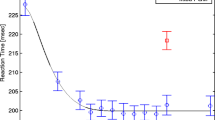Summary
The effects of loudness on the latency of evoked potentials and on simple reaction time were compared. It was found that both reaction time and the evoked-potential latency increases with decreasing stimulus intensity. However, different slopes of the curves were found. This is explained in terms of the arousal effect of loud auditory stimuli.
Similar content being viewed by others
References
Angel, A. (1973). Input-output relations in simple reaction time experiments. Quarterly Journal of Experimental Psychology, 25, 193–200.
Barr, M. (1983). A comparison of reaction-time and temporal-orderjudgment estimates of latency to sinusoidal gratings. Perception, 12, A7 (abstract).
Brauner, J. D., & Lit, A. (1976). The Pulfrich effect, simple reaction time, and intensity discrimination. American Journal of Psychology, 89, 105–114.
Collyer, C. E. (1976). The induced asynchrony effect: Its role in visual judgment of temporal order and its relation to other dynamic perceptual phenomena. Perception & Psychophysics, 18, 47–54.
Jaśkowski, P. (1987). The effect of retinal location on simple motor reaction time and perceived simultaneity. Perception, 16, 208 (abstract).
Jaśkowski, P. (1991). Perceived onset simultaneity of stimuli with unequal durations. Perception, 20, 715–726.
Jaśkowski, P. (1992). Temporal-order judgment and reaction time for short and long stimuli. Psychological Research, 54, 141–145.
Jaśkowski, P. (1992b). Temporal order judgment and reaction time to stimuli of different rise times. Perception (in press).
Jaśkowski, P., Pruszewicz, A., & Świdzińki, P. (1990). VEP latency and some properties of simple motor reaction time distribution. Psychological Research, 52, 28–34.
Jaśkowski, P., Rybarczyk, K., Jaroszyk, F., & Lemański, D. (1992). The effect of stimulus intensity on force output in simple reaction time task. (Submitted).
Menendez, A., & Lit, A. (1983). Effects of test-flash and steady background luminance on simple visual reaction time (RT) and perceived simultaneity (PS). Investigative Ophthalmology and Visual Sciences, 24, 5 (abstract).
Morgan, M. J. (1977). Differential visual persistence between the two eyes: A model for Fertch-Pulfrich effect. Journal of Experimental Psychology: Human Perception and Performance, 3, 484–495.
Nissen, M. J. (1977). Stimulus intensity and information processing. Perception & Psychophysics, 22, 338–352.
Niemi, P. (1979). Subjective intensity effects on auditory and visual reaction processes. Acta Psychologica, 43, 299–312.
Posner, M. I., Nissen, M. J., & Klein R. M. (1976). Visual dominance: An information-processing account of its origins and significance. Psychological Review, 83, 157–171.
Roufs, (1974). Dynamic properties of vision — V. Perception lag and reaction time in relation to flicker and flsh thresholds. Vision Research, 14, 853–869.
Sanders, A. F. (1983). Towards a model of stress and human performance. Acta Psychologica, 53, 61–97.
Sanders, A. F., & Wertheim, A. (1973). The relation between physical stimuli properties and the effect of foreperiod duration on reaction time. Quarterly Journal of Experimental Psychology, 25, 201–206.
Ulrich, R., & Stapf, K. H. (1984). A double response paradigm to study stimulus intensity effects upon the motor system in simple reaction time experiments. Perception & Psychophysics, 36, 545–558.
Vaughan, H. G., Jr., Costa, L. D., & Gilden, L. (1966). The functional relation of visual response and reaction time to stimulus intensity. Vision Research, 6, 645–656.
Williams, J. M., & Lit, A. (1983). Luminance-dependent visual latency for the Hess effect, the Pulfrich effect and simple reaction time. Vision Research, 23, 171–179.
Williamson, S. J., Kaufman, L., & Brenner, D. (1978). Latency of the neuromagnetic response of the human visual cortex. Vision Research, 18, 107–110.
Wilson, A. J., & Lit, A. (1981). Effects of photopic annulus luminance level on reaction time and on the latency of evoked cortical potential responses to target flashes, Journal of the Optical Society of America, 71, 1481–1486.
Author information
Authors and Affiliations
Rights and permissions
About this article
Cite this article
Jaskownki, P., Rybarczyk, K. & Jaroszyk, F. The relationship between latency of auditory evoked potentials, simple reaction time, and stimulus intensity. Psychol. Res 56, 59–65 (1994). https://doi.org/10.1007/BF00419712
Received:
Accepted:
Issue Date:
DOI: https://doi.org/10.1007/BF00419712




